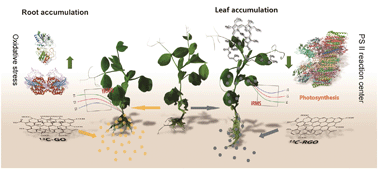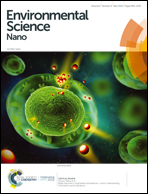Chemical reduction of graphene enhances in vivo translocation and photosynthetic inhibition in pea plants†
Abstract
Graphene-based nanomaterials have been used widely in various environmental applications such as water/soil decontamination. However, their environmental implications/biosafety must be properly evaluated. Most studies have focused on their accumulation in, and toxicity to, plant roots, but little is known about their tissue translocation and the risks of modified graphene materials. Here, using a 13C-stable isotope skeleton-labelling technique, we investigated the translocation of two graphene materials in pea plants (Pisum sativum L.) and their effects on photosynthesis in leaves. After the chemical reduction of graphene oxide (GO), the reduced GO (RGO) was translocated from roots into leaves and directly inhibited the activity of photosystem II (PS II) by damaging the oxygen-evolving-complex on the donor side, which was attributed to oxidative stress. These findings highlight the critical role of chemical reduction in the translocation of graphene materials in plants, and the potential risks of such materials to disrupt important metabolic processes in carbon cycle.



 Please wait while we load your content...
Please wait while we load your content...